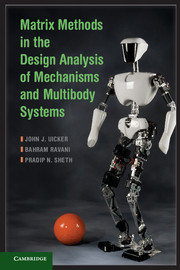Book contents
- Frontmatter
- Contents
- Preface
- About the Authors
- 1 Concepts and Definitions
- 2 Topology and Kinematic Architecture
- 3 Transformation Matrices in Kinematics
- 4 Modeling Mechanisms and Multibody Systems with Transformation Matrices
- 5 Posture Analysis by Kinematic Equations
- 6 Differential Kinematics and Numeric Solution of Posture Equations
- 7 Velocity Analysis
- 8 Acceleration Analysis
- 9 Modeling Dynamic Aspects of Mechanisms and Multibody Systems
- 10 Dynamic Equations of Motion
- 11 Linearized Equations of Motion
- 12 Equilibrium Posture Analysis
- 13 Frequency Response of Mechanisms and Multibody Systems
- 14 Time Response of Mechanisms and Multibody Systems
- 15 Collision Detection
- 16 Impact Analysis
- 17 Constraint Force Analysis
- Index
- References
7 - Velocity Analysis
Published online by Cambridge University Press: 05 April 2013
- Frontmatter
- Contents
- Preface
- About the Authors
- 1 Concepts and Definitions
- 2 Topology and Kinematic Architecture
- 3 Transformation Matrices in Kinematics
- 4 Modeling Mechanisms and Multibody Systems with Transformation Matrices
- 5 Posture Analysis by Kinematic Equations
- 6 Differential Kinematics and Numeric Solution of Posture Equations
- 7 Velocity Analysis
- 8 Acceleration Analysis
- 9 Modeling Dynamic Aspects of Mechanisms and Multibody Systems
- 10 Dynamic Equations of Motion
- 11 Linearized Equations of Motion
- 12 Equilibrium Posture Analysis
- 13 Frequency Response of Mechanisms and Multibody Systems
- 14 Time Response of Mechanisms and Multibody Systems
- 15 Collision Detection
- 16 Impact Analysis
- 17 Constraint Force Analysis
- Index
- References
Summary
Introduction
In Chapter 3 we defined the words position and posture as the terms that tell “where” an item is. Depending on the “item,” we find it convenient to use a Cartesian coordinate system as a global reference and we choose homogeneous coordinates to define the position of a point. We use the (4 × 4) transformation matrix T0b to represent the posture of a rigid body, and we refer to “posture” to emphasize that we include both the orientation of the body as well as the location of a reference point. The posture of a mechanism or multibody system can usually be described by a vector of generalized coordinates ψ equal in number to the mobility of the system. However, because it is sometimes possible that a system can be assembled in more than one way for identical values of the generalized coordinates, we choose to represent the posture of a system by the vector φ that explicitly includes all of the joint variables.
In Chapter 3 we defined the term displacement as the change in position or posture of a point, a joint variable, a rigid body, or a system. Then, in Chapter 6, we showed how the concept of differential displacement leads naturally to the derivative of position or posture. We defined the very powerful derivative operator matrices, Qh and Dh, to make the process of numeric differentiation both easy and precise. However, a quick review shows that derivatives are taken first with respect to a changing joint variable value because these are the variables on which the joint transformation matrices explicitly depend. Little is said about the fact that, in most mechanisms or multibody systems, many joint variables change simultaneously.
- Type
- Chapter
- Information
- Publisher: Cambridge University PressPrint publication year: 2013



